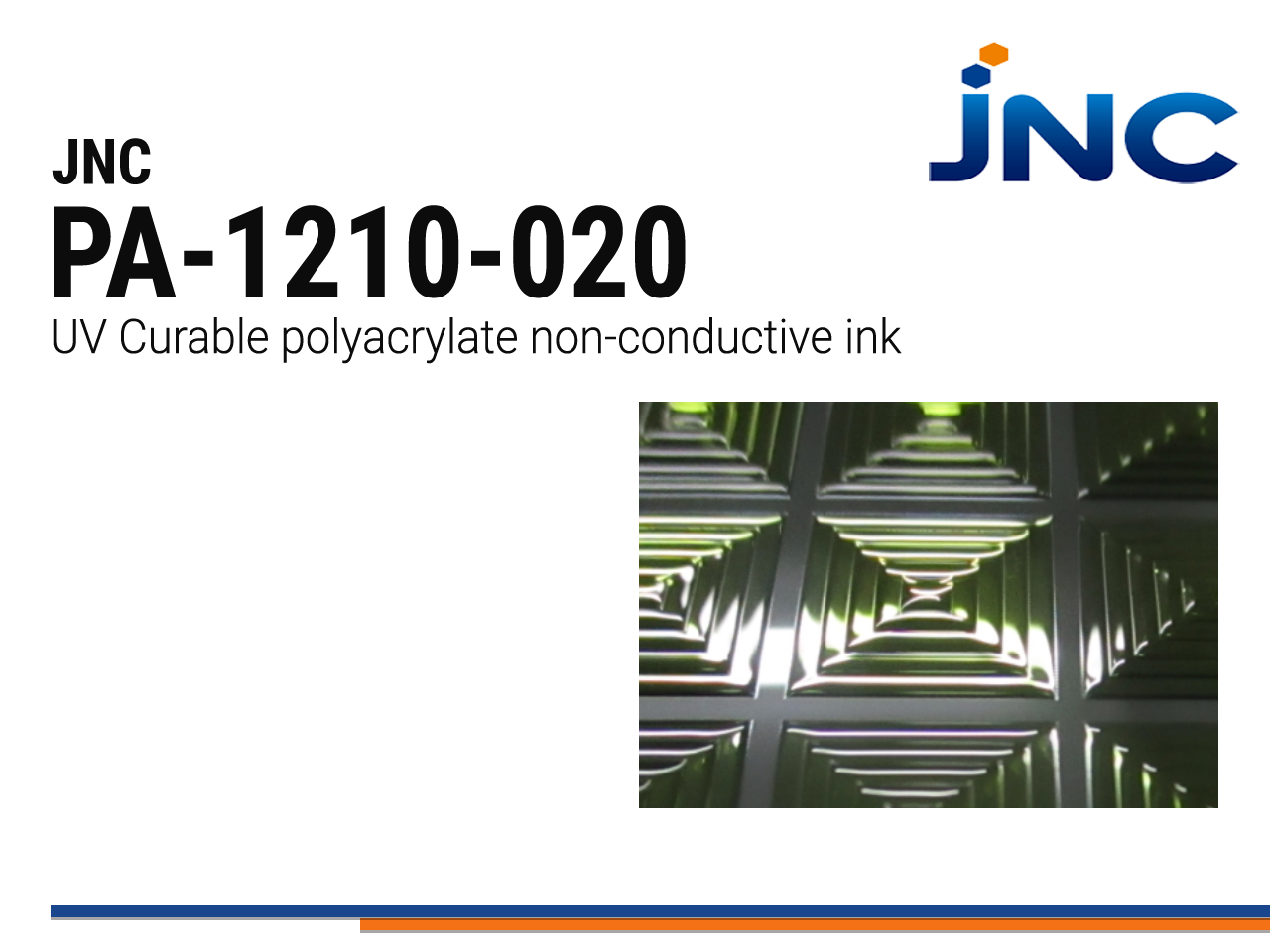JNC PA-1210-020 | Insulating Polyacrylate Ink
Harmonization Code : 32159090 | Printing ink, writing or drawing ink, and other inks, whether or not concentrated or solid, specifically for those classified as other within that category
Main features
- UV Curable/ Solvent free
- Standard
- Optoelectronics
Product Description
PA-1210-020 is a UV-curable, solvent-free polyacrylate insulating ink. Its advanced polyacrylate composition ensures robust dielectric properties of a breakdown voltage of 100 V/um and a dielectric constant of 3.2 @ 1 kHz, ensuring dependable electrical isolation and signal integrity for your components. Moreover, with its solvent-free formulation, PA-1210-020 contributes to a safer and more environmentally friendly production process, minimizing volatile organic compounds (VOCs) and reducing the ecological footprint.
Industry Applications:
Electronics Manufacturing | Optoelectronics | Microelectronics
Technical Specifications
| General Properties | |||||
| Process Method | Inkjet | ||||
| Solids | 100 % | ||||
| Physical Properties | |||||
| Viscosity Viscosity Viscosity is a measurement of a fluid’s resistance to flow. Viscosity is commonly measured in centiPoise (cP). One cP is defined as the viscosity of water and all other viscosities are derived from this base. MPa is another common unit with a 1:1 conversion to cP. A product like honey would have a much higher viscosity -around 10,000 cPs- compared to water. As a result, honey would flow much slower out of a tipped glass than water would. The viscosity of a material can be decreased with an increase in temperature in order to better suit an application | 23 mPa.s | ||||
| Chemical Properties | |||||
| Water Absorption | 0.2 % | ||||
| Electrical Properties | |||||
| Breakdown Voltage Breakdown Voltage Breakdown voltage is the minimum voltage necessary to force an insulator to conduct some amount of electricity. It is the point at which a material ceases to be an insulator and becomes a resistor that conducts electricity at some proportion of the total current. After dielectric breakdown, the material may or may not behave as an insulator any more because of the molecular structure alteration. The current flow tend to create a localised puncture that totally alters the dielectric properties of the material. This electrical property is thickness dependent and is the maximum amount of voltage that a dielectric material can withstand before breaking down. The breakdown voltage is calculated by multiplying the dielectric strength of the material times the thickness of the film. | 100 V | ||||
| Mechanical Properties | |||||
| Elongation Elongation Elongation is the process of lengthening something. It is a percentage that measures the initial, unstressed, length compared to the length of the material right before it breaks. It is commonly referred to as Ultimate Elongation or Tensile Elongation at break. | 3 % | ||||
| Thermal Properties | |||||
| |||||
| Glass Transition Temperature (Tg) Glass Transition Temperature (Tg) The glass transition temperature for organic adhesives is a temperature region where the polymers change from glassy and brittle to soft and rubbery. Increasing the temperature further continues the softening process as the viscosity drops too. Temperatures between the glass transition temperature and below the decomposition point of the adhesive are the best region for bonding. The glass-transition temperature Tg of a material characterizes the range of temperatures over which this glass transition occurs. | 116 °C | ||||
Additional Information
| Properties | PA-1210-020 |
| Solids content (wt. %) | 100 |
| Viscosity (mPa's) @25℃ | 23 |
| Surface tension (mN/m) @23℃ | 30 |
| Printing methods | Inkjet |
| Curing | 2,000mJ/cm2 @ 365nm |
| Post-curing | 175℃ 60min |
| Volume resistivity (Ω*cm) | 1E+16 |
| Breakdown voltage (V/um) | 100 |
| Dielectric constant (1kHz) @1V | 3.2 |
| Tensile modulus (MPa) | 1800 |
| Elongation (%) | 3 |
| Residual stress (MPa) | 12 |
| 5% weight loss temp (℃) | 275 |
| CTE ( | 55 |
| Tg (℃) | 116 |
| Water absorbance (%) @23℃ | 0.2 |





